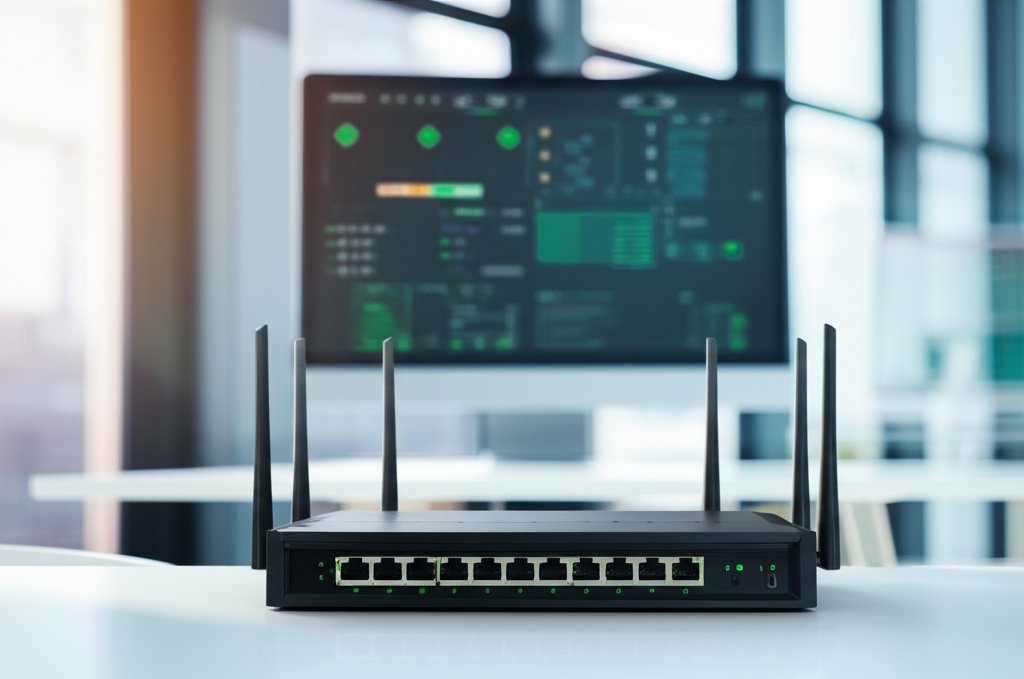In our increasingly digital world, relying solely on a strong, unique password is no longer a sufficient defense against the relentless tide of cyber threats. With a staggering 74% of organizations experiencing a data breach involving compromised credentials in the past year alone, the urgency for advanced security measures has never been clearer. Cyber threats are evolving at an alarming pace, making it absolutely crucial for every internet user and small business to look beyond traditional passwords for robust, proactive protection. This comprehensive FAQ article will demystify biometrics and Multi-Factor Authentication (MFA), explaining how these powerful technologies combine to offer unparalleled network security, empowering you to understand, implement, and secure your digital life effectively.
Ready to strengthen your digital defenses? Let’s dive in!
Table of Contents
- What is Multi-Factor Authentication (MFA)?
- What are Biometrics, and how do they work for security?
- Why are traditional passwords no longer enough for security?
- How do Biometrics and MFA combine to create strong security?
- What are the different types of MFA factors?
- How can everyday users enable MFA and Biometrics on their accounts?
- Which MFA methods are most recommended for individuals and small businesses?
- What are the main benefits of using Biometrics and MFA for small businesses?
- Are Biometrics private and safe from spoofing?
- Isn’t implementing MFA too complicated or expensive for a small business?
- What should I do if I lose my MFA device or forget a factor?
- What does a “passwordless” future look like with Biometrics and MFA?
Basics: Understanding the Foundation of Modern Security
What is Multi-Factor Authentication (MFA)?
Multi-Factor Authentication (MFA) is a critical security method that demands you provide two or more distinct verification factors to gain access to an account or system. Its purpose is simple: to definitively prove you are who you claim to be. By moving beyond just a password, MFA significantly escalates your security posture. Think of it not just as adding extra locks to your front door, but requiring a key and a specific security code to enter.
You’re likely more familiar with MFA than you think! If you’ve ever logged into your banking app and received a text message with a code, or used a rotating code from an authenticator app on your phone, you’ve engaged with MFA. It serves as a crucial, formidable layer of defense, making it exponentially harder for cybercriminals to access your accounts, even if they somehow manage to steal your password. Two-Factor Authentication (2FA) is simply a specific subset of MFA that employs exactly two factors.
What are Biometrics, and how do they work for security?
Biometrics are unique biological characteristics that can be leveraged to verify your identity, employing “something you are” as proof of access. These attributes are inherently tied to you, making them extraordinarily secure because they are exceptionally difficult to replicate or steal digitally. Instead of the burden of remembering complex, arbitrary passwords, you simply use a part of yourself.
Common biometric methods you probably already use include fingerprint scans to unlock your smartphone, facial recognition (like Face ID) for accessing apps or devices, and increasingly, voice recognition for certain services. When you authenticate with biometrics, your device or service converts your unique characteristic into an encrypted digital template. This template is then securely stored, typically locally on your device in a protected area, for comparison during future authentication attempts. This method makes security both robust and surprisingly convenient, integrating seamlessly into your daily digital interactions.
Why are traditional passwords no longer enough for security?
Traditional passwords, even those deemed “strong” with complex character combinations, are fundamentally vulnerable because they represent a single point of failure: “something you know.” Cybercriminals possess increasingly sophisticated tools and techniques designed to exploit this inherent weakness, rendering password-only security an unacceptable gamble for your digital assets. It’s akin to safeguarding your most valuable possessions with only a basic lock in a high-crime area.
Common threats like highly convincing phishing attacks can trick you into willingly revealing your credentials. Credential stuffing attempts leverage vast lists of stolen passwords from past breaches, trying them against other sites where you might have reused passwords. Brute-force attacks involve automated systems attempting countless password combinations until one succeeds. Furthermore, the phenomenon of “password fatigue” often leads individuals to reuse simple, easy-to-guess passwords across multiple platforms, creating a massive, exploitable security hole. We simply cannot rely on human memory and vigilance alone to protect our entire digital lives against these relentless and automated assaults anymore.
Intermediate: Layering Your Defenses for Enhanced Protection
How do Biometrics and MFA combine to create strong security?
The true power of modern, resilient security emerges when biometrics are integrated as a factor within a broader Multi-Factor Authentication framework. This combination creates a sophisticated, layered defense system, requiring an attacker to bypass multiple, fundamentally different types of authentication. This layered approach is incredibly difficult to compromise. For instance, you might first enter a PIN (something you know), and then verify your identity with your fingerprint (something you are). Alternatively, you could receive a push notification to your trusted device (something you have), which you then confirm using facial recognition.
This synergistic approach provides a significantly stronger shield against even the most sophisticated attacks. If a cunning phisher manages to steal your password, they are immediately stopped dead in their tracks without your fingerprint or your trusted device to provide the second factor. Conversely, if someone attempts to spoof your biometrics, they would still need your password or access to your device. This powerful synergy ensures that compromising one factor is insufficient to compromise your entire account, making your digital presence far more resilient against a wide spectrum of cyber threats.
What are the different types of MFA factors?
MFA fundamentally relies on at least two of three distinct categories, often referred to as the “three pillars of authentication.” Each category offers a different kind of protection, making it exponentially harder for an attacker to compromise your identity. Understanding these pillars is key to choosing the right blend of security for your specific needs:
- Something You Know: This category encompasses information only you should know, such as traditional passwords, Personal Identification Numbers (PINs), or answers to secret security questions. While foundational, this factor is the weakest on its own due to vulnerabilities like phishing and brute-force attacks.
- Something You Have: This refers to physical objects that are in your possession. Examples include your smartphone (used for authenticator apps or receiving SMS codes), physical security keys (e.g., YubiKey, Google Titan Key), smart cards, or hardware tokens. These methods are generally quite secure, as an attacker would need physical access to your device.
- Something You Are: This is where biometrics come into play – your unique biological characteristics. This includes fingerprints, facial recognition, iris scans, or even your voice. These are considered highly secure and offer significant convenience, as they are inherently tied to your physical self.
Combining factors from different pillars is paramount to achieving robust MFA and building a truly resilient security posture.
How can everyday users enable MFA and Biometrics on their accounts?
Enabling Multi-Factor Authentication (MFA) and biometrics is arguably the single most impactful step you can take to secure your digital life, and it’s often far simpler than you imagine. This isn’t just about adding a layer of security; it’s about taking tangible control. Follow these clear, step-by-step instructions to fortify your accounts:
- Prioritize Your Most Critical Accounts: Start with the accounts that hold the most sensitive information or serve as recovery points for others.
- For Individuals: Your primary email account (often the master key to everything else), online banking, cloud storage (e.g., Google Drive, Dropbox, iCloud), and social media profiles.
- For Small Businesses: Your company’s email system (e.g., Google Workspace, Microsoft 365), accounting software, CRM systems, communication platforms (e.g., Slack, Microsoft Teams), and any mission-critical SaaS applications.
- Enable Biometrics on Your Devices:
- Smartphones and Tablets: Go to your device’s “Settings,” then look for “Security & privacy,” “Biometrics & password,” or “Face ID & Passcode.” Enable fingerprint unlock, facial recognition, or iris scanning. This secures the device itself and can be used for app authentication.
- Laptops/Desktops: Many modern laptops include fingerprint readers or facial recognition cameras. Check your operating system’s settings (e.g., “Sign-in options” in Windows, “Touch ID” or “Face ID” in macOS) to enable these convenient login methods.
- Enable MFA on Your Online Services: This is where you add an extra factor beyond your password.
- Locate Security Settings: Log into each prioritized online service. Navigate to your “Account Settings,” “Security,” “Privacy,” or “Login & Security” section.
- Find MFA/2FA Option: Look for options explicitly labeled “Two-Factor Authentication (2FA),” “Multi-Factor Authentication (MFA),” “Login Verification,” or “Advanced Security.”
- Choose Your Method (Recommended Order):
- Authenticator App: This is generally the most secure and recommended method. The service will provide a QR code to scan with an authenticator app (like Google Authenticator, Microsoft Authenticator, or Authy) on your smartphone. The app will then generate time-sensitive codes you’ll enter during login.
- Physical Security Key (e.g., YubiKey): If available and you have one, this offers the highest security. The service will guide you through registering the key.
- SMS Text Message/Email: While less secure due to potential SIM-swapping or email compromise, this is better than no MFA. You’ll typically enter your phone number or confirm your email to receive a code. Only use if higher security options are not available.
- Follow Prompts and Save Recovery Codes: The service will walk you through the setup. Crucially, when offered, save your recovery codes in a secure, offline location (e.g., printed and stored in a safe) or within a reputable password manager. These are vital if you lose your MFA device.
By following these steps, you’ll significantly reduce your vulnerability to common cyberattacks. Don’t delay—your digital security depends on it.
Which MFA methods are most recommended for individuals and small businesses?
For the majority of individuals and small businesses, authenticator apps strike an excellent balance between robust security and everyday convenience, making them a highly recommended choice. However, for maximum security on truly sensitive accounts, physical security keys represent the gold standard. Let’s explore why, so you can make informed decisions tailored to your specific needs.
- Authenticator Apps (e.g., Google Authenticator, Microsoft Authenticator, Authy): These applications generate time-sensitive, one-time codes directly on your smartphone, even without an internet connection. They are generally considered much more secure than SMS codes because they do not rely on your mobile carrier’s network, which can be susceptible to sophisticated SIM-swapping attacks. Authenticator apps are typically free, straightforward to set up for most services, and provide strong protection.
- Physical Security Keys (e.g., YubiKey, Google Titan Key): These small, specialized USB or Bluetooth devices offer the highest level of security available for MFA. You physically plug them in or tap them to authenticate. They are virtually immune to phishing and most remote attacks because they rely on cryptographic proof of presence. Physical keys are ideal for extremely sensitive accounts (e.g., cryptocurrency exchanges, cloud provider admin accounts) or for individuals and businesses requiring top-tier, uncompromisable protection.
- Biometrics: Where available and seamlessly integrated into an MFA workflow (e.g., using your fingerprint to approve a login on your phone after a push notification), biometrics (fingerprint, facial recognition) are incredibly convenient and secure. They often serve as one of the factors, particularly on mobile devices, providing a rapid and intuitive authentication experience.
- SMS/Email Codes: While undeniably better than having no MFA at all, these methods are generally the least secure due to potential vulnerabilities like SIM-swapping attacks (for SMS) or email account compromise (for email codes). Use them if no other, stronger option is available, but always prioritize an authenticator app or a physical security key when possible.
Advanced: Strategic Implementation and Futureproofing
What are the main benefits of using Biometrics and MFA for small businesses?
For small businesses, embracing biometrics and Multi-Factor Authentication isn’t merely about adopting a recommended practice; it’s a critical, strategic investment that fortifies your digital assets, safeguards sensitive customer and company data, and significantly reduces the severe financial and reputational risks associated with cyber breaches. In today’s threat landscape, MFA is your strongest defense against the most common and damaging attacks targeting small businesses.
- Drastically Reduced Risk of Data Breaches: MFA makes it exponentially harder for attackers to gain unauthorized access, even if they manage to steal employee passwords. This directly protects invaluable assets such as client lists, financial records, intellectual property, and proprietary business data.
- Robust Protection Against Phishing & Credential Theft: Even if an employee, through no fault of their own, falls victim to a sophisticated phishing scam and unknowingly gives up their password, MFA ensures the attacker is stopped dead in their tracks without the second factor (e.g., their authenticator app or physical key).
- Improved Regulatory Compliance: Many industry regulations and data security standards (such as HIPAA, PCI DSS, GDPR) increasingly recommend or mandate stronger authentication protocols. Implementing MFA helps businesses meet these critical compliance requirements, avoiding hefty fines and legal repercussions.
- Enhanced User Experience & Productivity: While there may be a minor initial learning curve, the integration of biometrics often speeds up login processes, eliminating the need to type complex passwords. Moreover, the peace of mind that comes from knowing accounts are robustly secured can boost employee confidence and reduce security-related anxieties, leading to improved overall productivity.
- Cost-Effective, Enterprise-Grade Security: Many powerful MFA solutions, including most authenticator apps, are free or very affordable. Even physical security keys represent a modest, one-time purchase. Compared to the staggering financial costs, business disruption, and reputational damage of recovering from a cyberattack, these solutions offer enterprise-grade security without a hefty price tag.
Are Biometrics private and safe from spoofing?
Yes, modern biometric systems are meticulously designed with privacy and security as core, foundational principles, and they employ advanced techniques to prevent common spoofing attempts. Your unique biological data isn’t typically stored as a raw image or recording that could be easily stolen or replicated. Instead, it’s converted into an encrypted, irreversible digital template. This process ensures that your actual fingerprint, facial image, or voice isn’t directly exposed or reconstructible from the stored data.
When you use biometrics, the template data is usually stored locally on your device (e.g., within a secure enclave on your smartphone or a Trusted Platform Module on your computer), and crucially, it is almost never sent to a central server in its raw or reconstructible form. Furthermore, sophisticated “liveness detection” technologies are now standard, utilizing advanced sensors and algorithms to differentiate between a real, live human and a photograph, mask, deepfake, or artificial replica. While no security system can ever be declared 100% foolproof, combining biometrics with another distinct MFA factor makes it incredibly difficult for an attacker to spoof both simultaneously, significantly bolstering your protection against even determined adversaries.
Isn’t implementing MFA too complicated or expensive for a small business?
This is a common and understandable misconception, but for most small businesses, implementing Multi-Factor Authentication is neither overly complicated nor prohibitively expensive. In fact, the vast majority of modern business applications and cloud services have seamlessly integrated MFA options that are surprisingly easy to set up, often requiring just a few clicks from an administrator. The investment in MFA is truly minimal when weighed against the potentially devastating cost of a data breach, which can cripple or even close a small business. The goal is to implement accessible solutions.
Consider these compelling points:
- Exceptional Ease of Setup: Leading services like Google Workspace, Microsoft 365, popular CRMs, and accounting software all offer robust, built-in MFA features that guide administrators and users through the setup process step-by-step. Training your team on how to use authenticator apps or physical keys is typically straightforward and requires minimal time.
- Abundant Affordable/Free Options: Free authenticator apps (such as Google Authenticator, Microsoft Authenticator, Authy) are readily available and provide strong security. Many physical security keys are a one-time, modest purchase, representing an incredibly budget-friendly investment compared to the potential costs of recovering from a cyberattack, including forensic investigations, legal fees, customer notification expenses, and reputational damage.
- Scalability for Growth: MFA solutions exist that can easily grow with your business, from simple individual setups for a handful of employees to more centralized management tools if your organization expands, ensuring your security measures evolve alongside your company.
The biggest hurdle for many small businesses is often simply getting started, but the profound benefits and peace of mind derived from enhanced security far outweigh any initial effort.
What should I do if I lose my MFA device or forget a factor?
Having a well-thought-out backup plan for your Multi-Factor Authentication is absolutely crucial, because losing a device or forgetting a factor can quickly escalate into a significant headache and potential lockout if you’re not prepared. Most reputable services provide robust recovery options, but it is imperative that you set them up before an incident occurs. Don’t wait until you’re locked out – establish a solid safety net today.
Here’s what you should proactively set up to ensure continuous access and security:
- Recovery Codes: When initially setting up MFA, most services will generate and present you with a list of one-time recovery codes. These are your lifeline. Print these codes out and store them securely offline (e.g., in a locked drawer, a fireproof safe, or a secure password manager that offers encrypted, offline storage). Never store them digitally on the same device you use for MFA.
- Backup MFA Method: If your primary method is an authenticator app, actively consider setting up a secondary, distinct MFA method. This could be a physical security key registered to the same accounts, or having a trusted phone number on file for SMS codes (though less secure, it serves as a last-resort backup), if the service allows for multiple methods.
- Trusted Contacts/Devices: Some advanced services allow you to designate trusted contacts or devices that can assist you in recovering access in emergencies. Ensure these are individuals or devices you absolutely trust implicitly.
- Password Manager Integration: Many advanced password managers offer built-in MFA code generation alongside your stored credentials. This allows you to centralize your passwords and MFA codes in one encrypted vault, which itself can be backed up and secured with a strong master password and potentially its own MFA.
By taking these preventative steps, you empower yourself to regain access to your accounts swiftly and securely, even in unforeseen circumstances.
What does a “passwordless” future look like with Biometrics and MFA?
The “passwordless” future is rapidly transitioning from concept to tangible reality, driven by the inherent security advantages and profound convenience offered by biometrics and advanced Multi-Factor Authentication. This future promises a world where the burden of memorizing complex, arbitrary character strings becomes an artifact of the past. Imagine logging into all your digital accounts instantly and securely, simply by using your unique face or a fingerprint. This isn’t science fiction; it is rapidly becoming our present reality.
This envisioned future features authentication methods where your primary identity verification comes from “something you are” (biometrics) or “something you have” (a trusted device or a physical security key), often intelligently combined with a simple, memorable PIN or gesture. Groundbreaking technologies and standards, such as FIDO (Fast Identity Online) alliances, are actively paving the way, enabling services to replace vulnerable passwords with cryptographically secure keys stored directly on your personal devices. This paradigm shift not only dramatically enhances security by eliminating the weakest link (the reusable, guessable password) but also fundamentally streamlines the user experience, making digital interactions faster, more intuitive, and significantly more resilient against modern cyber threats. The accelerating trend toward a truly passwordless world will further integrate these advanced techniques, making digital life safer and remarkably simpler for everyone.
Related Questions
For more deep dives into specific security strategies and to further strengthen your digital defenses, we encourage you to explore these additional resources:
- Learn how to strengthen your overall network defenses, especially for IoT devices.
- Discover comprehensive Multi-Layered Security approaches that extend beyond basic protections.
- Explore advanced strategies for Network Security Beyond traditional security models.
Conclusion: Fortify Your Digital Walls Today
In a landscape where digital threats constantly evolve, relying solely on passwords is a gamble no one can afford. Moving beyond simple passwords isn’t just an option anymore; it’s a fundamental necessity for robust digital security. Throughout this guide, we’ve demystified biometrics and Multi-Factor Authentication (MFA), demonstrating how these powerful, yet accessible, technologies combine to build truly formidable digital defenses around your personal information and your business assets.
By understanding the “something you know, have, and are” pillars, and strategically implementing MFA with biometrics, you’re not just adding layers of protection—you’re fundamentally altering the security equation in your favor. Whether you are an individual safeguarding private accounts or a small business owner protecting an entire operation, the path to stronger security is clear and actionable.
Key Takeaways for Digital Empowerment:
- Passwords Alone Are Not Enough: Cybercriminals regularly bypass single-factor authentication, making your accounts vulnerable.
- MFA is Your Strongest Defense: It requires multiple, distinct forms of verification, making unauthorized access incredibly difficult, even if a password is stolen.
- Biometrics Offer Both Security & Convenience: Leveraging “something you are” (fingerprint, face, voice) adds a highly secure and remarkably user-friendly factor to your authentication process.
- Implementation is Easier Than You Think: Most modern services offer straightforward setup processes for MFA and biometrics, making it accessible for individuals and businesses alike.
- Always Have a Recovery Plan: Crucially, save your recovery codes securely offline and consider setting up backup MFA methods to prevent account lockout.
Your digital security is ultimately in your hands. Take control, implement these essential strategies today, and empower yourself against the growing tide of cyber threats. It’s time to build unbreakable digital walls and secure your future online.









